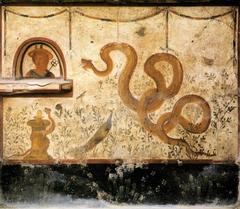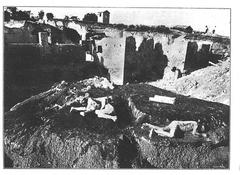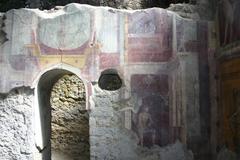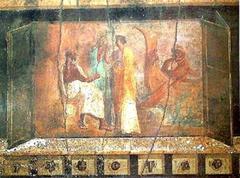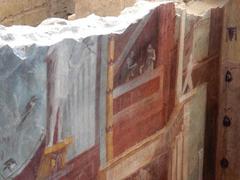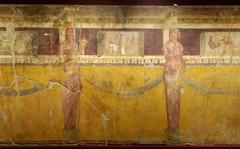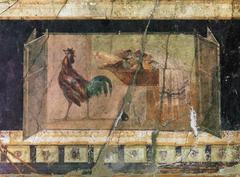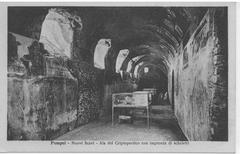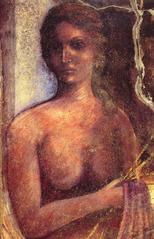
House of Cryptoporticus Visiting Hours, Tickets, and Guide: Pompeii Historical Site
Date: 14/06/2025
Introduction
The House of the Cryptoporticus (Casa del Criptoportico, I.6.2) in Pompeii is a striking example of Roman domestic luxury, architectural ingenuity, and the social aspirations of the ancient elite. Situated in the affluent Regio I district, this domus is famed for its namesake cryptoporticus—a vaulted, semi-subterranean corridor that provided cool respite during the Mediterranean summers. The house, dating to the late 2nd century BCE, features an intricate layout of atrium, peristyle garden, loggia, and private baths, all adorned with vivid frescoes and mosaics. Preserved under the volcanic ash of the 79 CE eruption, it offers visitors and scholars alike a detailed portrait of daily life and social dynamics in Roman Pompeii. This comprehensive guide details the site’s historical and cultural significance, architectural highlights, visitor information, accessibility, travel tips, and nearby attractions, helping you make the most of your visit. For the latest updates, turn to the official Pompeii Archaeological Park website and digital resources such as the Audiala app (ArchUp; Pompeii Archaeological Park; Expanded Interiors).
Table of Contents
- Historical Overview
- Artistic and Architectural Highlights
- Visiting Information
- Nearby Attractions
- Archaeological Discovery and Recent Research
- Frequently Asked Questions (FAQ)
- Conclusion
- Visuals and Media
- References
Historical Overview
Origins and Evolution
Located near the bustling Via dell’Abbondanza and the Forum, the House of the Cryptoporticus was constructed in the late second century BCE, during a period of urban growth in Pompeii (ArchUp; Expanded Interiors). Around 40–30 BCE, the house expanded by absorbing the adjacent Casa del Saccello Iliaco, a testament to the increasing wealth and social prominence of its owners.
Unique Features and Expansion
At the heart of the property is the cryptoporticus, a semi-subterranean, vaulted corridor running along the peristyle garden. Unlike typical Pompeian houses, this feature emulated the grandeur of countryside villas and provided a cool, shady retreat during summer (Expanded Interiors). The estate also boasted a private bath suite—a rare luxury in urban Pompeii—lavishly adorned with Second Style frescoes and intricate mosaics (ArchUp).
Later Modifications
By the first century CE, parts of the cryptoporticus were further vaulted and corridors closed off, reflecting evolving domestic needs and the aftermath of the 62 CE earthquake. Eventually, the property was subdivided, mirroring broader social shifts within the city (ArchUp).
Artistic and Architectural Highlights
Frescoes and Mosaics
The House of the Cryptoporticus is celebrated for its frescoes, particularly those in the cryptoporticus and baths. These works showcase the Second Style’s illusionistic architectural vistas and mythological themes, including scenes from the Iliad and Aethiopis. The use of costly pigments like cinnabar red signaled the family’s affluence (Walks of Italy; Dark Rome). Later renovations introduced Third Style frescoes, with linear motifs and central vignettes.
Mosaics throughout the house range from simple black-and-white geometric designs in service areas to vibrant polychrome compositions in reception rooms, often depicting mythological or marine themes (Pompeii Archaeological Park).
Layout and Construction
The house’s main entrance opens onto an atrium surrounded by cubicula (bedrooms) and an alae (side room). Beyond lies the tablinum (main reception room) and then the peristyle garden. The cryptoporticus wraps around the garden’s eastern and southern sides, accessed by stairs and bathed in dappled light from high windows.
Built using opus incertum (irregular stonework) and local tufa and lava stones, the structure is both robust and earthquake-resistant. The house’s integration of indoor and outdoor spaces—atrium, peristyle, cryptoporticus, and loggia—reflects the Roman ideal of blending luxury, utility, and social display (Dark Rome).
Visiting Information
Hours and Tickets
- Opening Hours: Generally open daily as part of the Pompeii Archaeological Park, from 9:00 AM to 7:00 PM (last admission 5:30 PM) in summer, and 9:00 AM to 5:00 PM (last admission 3:30 PM) in winter. Confirm times on the official website before your visit.
- Tickets: Entry included with the general Pompeii ticket (approx. €16 standard adult; discounts for EU residents under 25 and children under 18). Tickets are available online or at site entrances. Special combined tickets for Herculaneum and Vesuvius are also available.
Accessibility
While Pompeii has improved accessibility with ramps and marked paths, the House of the Cryptoporticus retains uneven floors and steps, especially in the cryptoporticus and garden areas. Visitors with mobility needs should check current conditions in advance.
Directions and Amenities
-
Getting There:
- By Train: Circumvesuviana line from Naples or Sorrento to Pompeii Scavi–Villa dei Misteri station, a short walk from the site entrance.
- By Bus: Regional buses connect Naples, Sorrento, and Pompeii.
- By Car: Paid parking lots are available near the entrances.
-
On-site Amenities:
- Restrooms, cafes, and a visitor center are available within the archaeological park.
- Maps and guides are provided at the entrance.
Guided Tours and Tips
- Tours: Guided tours (including those by archaeologists or art historians) are highly recommended for deeper insight. Audio guides and digital resources (e.g., Audiala app) can enhance your experience.
- Tips:
- Wear comfortable shoes for uneven terrain.
- Bring water and sun protection during warmer months.
- Arrive early or late in the day to avoid crowds.
- Photography without flash is permitted; drones are not allowed.
Nearby Attractions
While exploring the House of the Cryptoporticus, consider adding these major sites to your itinerary:
- House of the Faun
- Villa of the Mysteries
- Amphitheatre
- Forum and Temple of Apollo
All are within walking distance and provide a comprehensive look at Pompeii’s urban and elite culture (thetourguy.com).
Archaeological Discovery and Recent Research
The 79 CE eruption of Mount Vesuvius preserved the House of the Cryptoporticus under a thick layer of ash. Excavations in the 20th century revealed its exceptional layout and art, although some frescoes were lost to wartime bombing (ArchUp). Recent DNA studies of remains found in the house have revealed unexpected insights into household composition, gender identities, and Pompeii’s cosmopolitan population (Smithsonian Magazine; studyfinds.org). Ongoing conservation efforts and digital reconstructions (such as the Expanded Interiors project) continue to shed light on the site’s history and artistry (Expanded Interiors).
Frequently Asked Questions (FAQ)
Q: What are the House of Cryptoporticus visiting hours?
A: Typically 9:00 AM–7:00 PM in summer, 9:00 AM–5:00 PM in winter. Always confirm on the official site.
Q: How much do tickets cost?
A: Standard adult tickets are about €16; discounts and free entry are available for certain categories.
Q: Is the site accessible for people with disabilities?
A: Some accessible paths exist, but expect uneven ground and stairs in the cryptoporticus. Contact the park for specific accessibility information.
Q: Are guided tours available?
A: Yes, many group and private tours include the House of the Cryptoporticus. Audio and app-based guides are also available.
Q: Can I take photos inside?
A: Yes, non-flash photography is permitted; drones are prohibited.
Conclusion
The House of the Cryptoporticus is a highlight of Pompeii, offering a richly layered view into the life, art, and social structure of Rome’s ancient elite. Its innovative architecture, sumptuous decoration, and poignant archaeological finds provide an immersive experience for both casual visitors and history enthusiasts. Careful planning—regarding hours, tickets, accessibility, and guided options—will maximize your visit. Make use of digital resources like the Audiala app and the official Pompeii website to enrich your exploration. The House of the Cryptoporticus stands as a testament to the complexity, creativity, and enduring legacy of Pompeian society.
Visuals and Media
[Virtual tour link or embedded interactive media if available]
References and Further Reading
- ArchUp: History of the House of the Cryptoporticus
- Expanded Interiors Project: House of the Cryptoporticus Pompeii
- Pompeii Archaeological Park: Exploring Pompeii’s Ruins
- Smithsonian Magazine: DNA Evidence Is Rewriting the Stories of Victims Who Perished in Pompeii
- Walks of Italy: Pompeii Art Guide
- Dark Rome: Ancient Architecture at Pompeii
- roman-gardens.github.io: House of the Cryptoporticus
- evendo.com: House of the Cryptoporticus
- thetourguy.com: Top 15 Things to See at Pompeii
- studyfinds.org: Ancient DNA Pompeii Victims
